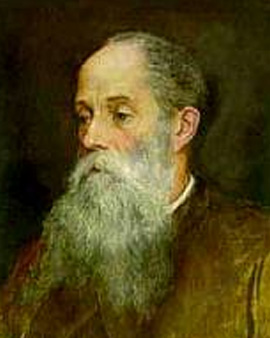John Roddam Spencer Stanhope was a British painter whose style can be attributed to second-generation Pre-Raphaelism, but also to British symbolism and aestheticism. He came from a wealthy family and grew up with an older brother and four sisters. Since his brother Walter inherited the family's lands and was in charge of them, Stanhope was able to decide more freely on his professional future. Stanhope decided to become a painter and studied in Oxford with the British painter and sculptor George Frederick Watts. Later he also became Watt's assistant and assisted him with some architectural paintings. He accompanied Watts on his trips to Italy and Anatolia. When she returned to Britain, Stanhope was invited by Dante Gabriel Rossetti, one of the founders of the Pre-Raphaelite Brotherhood, to work on a large mural in Oxford. Stanhope's contribution to this project was "Sir Gawaine and the Damsels".
After his marriage to Elizabeth King in 1859, the couple first settled in a small town in South Yorkshire. The following year their only daughter Mary was born. Since Stanhope suffered from chronic asthma, they decided to move to the South of England in the same year. For this purpose he commissioned a property from the distinguished British architect Philip Webb. By Stanhope's standards, the house was very modest and primarily functional. It was intended to provide optimal conditions for his work. There were two studios connected by a door, a waiting room and a dressing room for models. A regular guest and good friend of Stanhope was the painter Edward Burne-Jones. Many paintings by Burne-Jones were inspired by the landscape around Stanhope's house. The move did not alleviate Stanhope's chronic complaints. Therefore, after their daughter died of scarlet fever at the age of 7, the couple decided to give up their house. From then on, Stanhope and his wife spent their winters in Florence. They returned to England in the summer and initially lived in the house of their friend Burne-Jones. Later Stanhope spent the summers in the same house as the Victorian painter Augustus Egg.
From the 1880s Stanhope lived and worked exclusively in Florence. His most important student was his niece Evelyn De Morgan. However, Evelyn's parents, Stanhope's sister Anna and her husband, hardly accepted him as an artist and held him and his achievements in low esteem. For Stanhope was not an artist by classical standards and the artists such as Burne-Jones and other Pre-Raphaelites with whom he was closely associated were considered unconventional. Stanhope therefore moved outside the British mainstream and did not exhibit at the Royal Academy, but was regularly represented with his works in the Gosvenor Gallery, a counter-movement to the academically influenced Royal Academy. Today, the painting "Love and The Maiden" from 1877 is considered a masterpiece and the most outstanding work by Stanhope.
×





.jpg)
.jpg)
.jpg)
.jpg)
.jpg)
.jpg)
.jpg)
.jpg)
.jpg)
.jpg)
.jpg)
.jpg)
.jpg)
.jpg)
.jpg)
.jpg)
.jpg)
.jpg)
_-_(MeisterDrucke-1111296).jpg)
_-_(MeisterDrucke-1111296).jpg)
.jpg)
.jpg)
_-_(MeisterDrucke-1466459).jpg)
_-_(MeisterDrucke-1466459).jpg)
.jpg)
.jpg)
.jpg)
.jpg)
_-_(MeisterDrucke-319338).jpg)
_-_(MeisterDrucke-319338).jpg)
.jpg)
.jpg)
_(pair_to_359451)_-_(MeisterDrucke-1127631).jpg)
_(pair_to_359451)_-_(MeisterDrucke-1127631).jpg)
.jpg)
.jpg)
.jpg)
.jpg)
.jpg)
.jpg)
_the_daughter_of_Aiah_par_Stanh_-_(MeisterDrucke-960119).jpg)
_the_daughter_of_Aiah_par_Stanh_-_(MeisterDrucke-960119).jpg)
.jpg)
.jpg)
.jpg)
.jpg)
.jpg)
.jpg)
 - (MeisterDrucke-220084).jpg)
 - (MeisterDrucke-220084).jpg)
.jpg)
.jpg)
.jpg)
.jpg)
.jpg)
.jpg)
_par_Sta_-_(MeisterDrucke-995262).jpg)
_par_Sta_-_(MeisterDrucke-995262).jpg)
_-_(MeisterDrucke-1129451).jpg)
_-_(MeisterDrucke-1129451).jpg)
.jpg)
.jpg)
_-_(MeisterDrucke-1130194).jpg)
_-_(MeisterDrucke-1130194).jpg)
_-_(MeisterDrucke-1127630).jpg)
_-_(MeisterDrucke-1127630).jpg)
.jpg)
.jpg)
.jpg)
.jpg)
.jpg)
.jpg)
.jpg)
.jpg)
_-_(MeisterDrucke-1641446).jpg)
_-_(MeisterDrucke-1641446).jpg)
.jpg)
.jpg)
.jpg)
.jpg)
 - (MeisterDrucke-149324).jpg)
 - (MeisterDrucke-149324).jpg)
.jpg)
.jpg)
_(pair_to_359450)_-_(MeisterDrucke-1129842).jpg)
_(pair_to_359450)_-_(MeisterDrucke-1129842).jpg)
.jpg)
.jpg)
.jpg)
.jpg)
.jpg)
.jpg)






